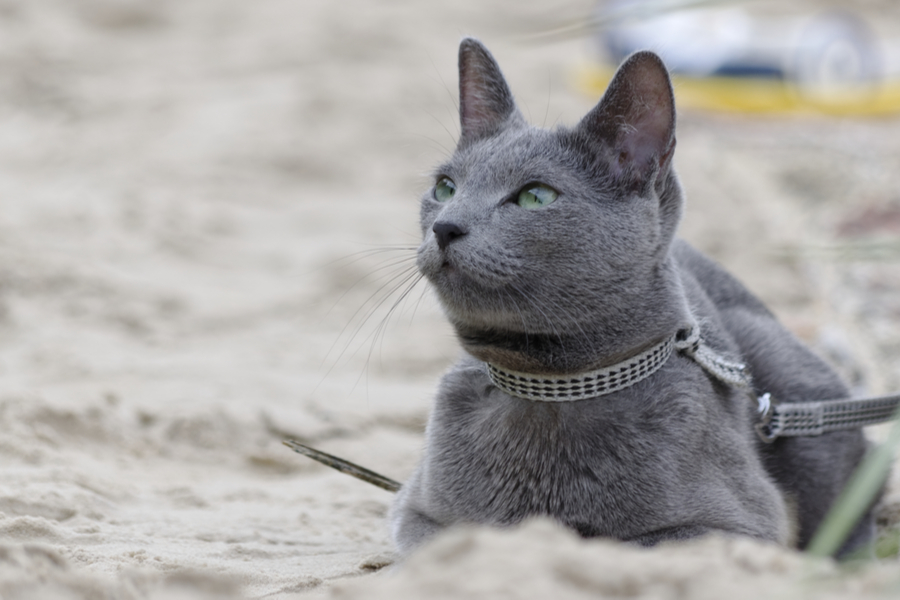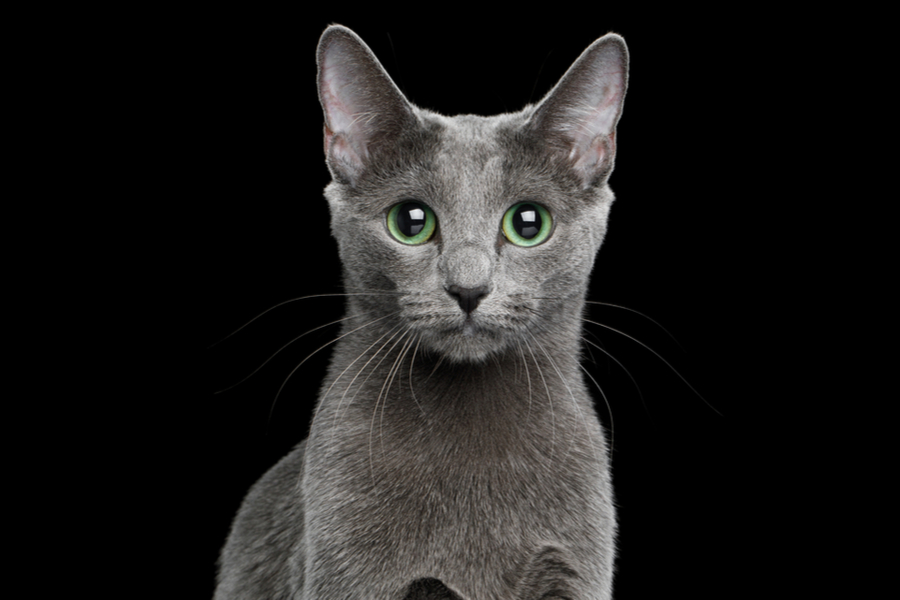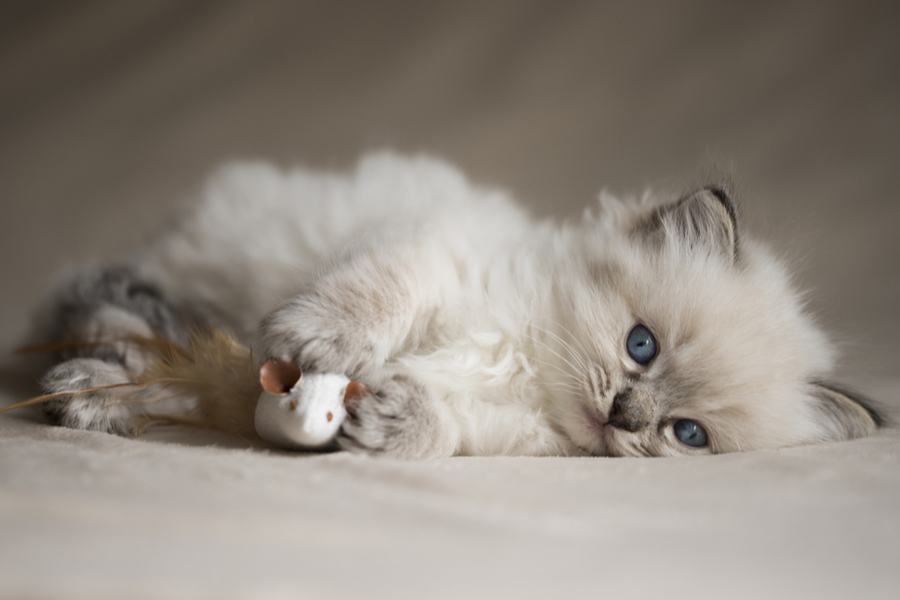Average sizes and life expectancy for this breed:
Greyhounds are considered to be one of the most ancient dog breeds in the world. They originated in Ancient Egypt and have been prized as devoted companions ever since. Cleopatra, General Custer, and Queen Elizabeth I of England are just some of the historical figures that were enchanted by Greyhounds. They are also dubbed the “Sport of Queens” because of the two queens' patronage.
Apart from their royal fans, there are many reasons why Greyhounds are loved around the world. They combine an elegant, majestic appearance with a welcoming attitude to people and other dogs. Faithful and loving with their family, they will let you know by barking or through a delicate pricking of their small, folded ears that someone is approaching your home.
Greyhounds have a status for having high energy levels. However, in reality, their favourite pastime is sleeping. This dog breed was designed to be a sprinter, not a long-distance runner. Greyhounds are generally satisfied with a daily walk as long as they get regular affection from their favourite people. These dogs can do well in apartments or homes with small yards. But make sure to put a solid fence around your garden to keep them from dashing after animals that they might see as prey, such as rabbits, squirrels, or trespassing neighbourhood cats.
Even with their strong prey drive, there is no doubt that this is an excellent dog breed that merits many belly rubs. Whether you acquired your Greyhound from a show breeder or adopted them from the racetrack, you will find yourself respecting this dog breed with the same appreciation that others have given it during its long and celebrated history.
Today, Greyhounds also partake in many other canine sports, such as lure conformation, coursing, agility, and obedience. Aside from their grace and speed, dog lovers adore them for their sweet, calm natures. Fans of the dog breed repeatedly claim that Greyhounds have two speeds: all-out sprint and total couch potato. But note that they are rather sensitive, both to extreme weather and loneliness. This is not a dog breed that can be left alone for long periods of time. Give them the love, attention, care, and exercise they desire, and you will have an affectionate, cuddle bug canine companion for life.
See available puppies




Tracing back over 8,000 years, Greyhounds are one of the oldest dog breeds in the world. They have been depicted in early cave drawings and ancient Egyptian artifacts. Various explanations have been debated over the origin of the name Greyhound. One of these suggestions is that the original Greyhound was mainly grey in colour. Another explanation is that the name originates from the Old English "grei," meaning dog, and "hundr," meaning hunter. The name could also come from the term Greekhound because the dog breed first arrived in England through the Greeks.
Whatever the origin of the name is, the Greyhound we know today closely resembles the aristocratic dog portrayed in art and literature throughout history. This dog breed has long been linked with royalty. In fact, English law commanded that no "mean person" be permitted to have a Greyhound from the 11th to the 14th century. Furthermore, in Ancient Egypt and Greece, they were revered as Gods and only people of royal blood were allowed to own them. They were also regularly depicted alongside paintings and portraits of Gods and Goddesses. For example, Hecate, the Goddess of Wealth, was often accompanied by a Greyhound. In addition, Greyhounds are the only dog breed to be mentioned in the Bible.
During the Middle Ages, Greyhounds were at risk of extinction due to the spread of famine and disease. However, they were thankfully saved by priests who bred them for noblemen.
For thousands of years, this fantastic dog breed was bred to hunt by outrunning their prey. Greyhounds can run at speeds of over 40 miles per hour! They are also very agile and athletic, with the skill to manoeuvre effortlessly and anticipate every move of their prey.
In 1912, a mechanical lure was designed by Owen Patrick Smith in North America. This was the birth of Greyhound track racing. The first track to use this device with Greyhounds was the Miami Kennel Club in Florida in 1923. Even today, Florida remains the leading state for Greyhound racing across America.
During this time, the Greyhound started to split into racing and show varieties, which began to differ in appearance over the years. Racing Greyhounds tend to be slim and long-legged, show Greyhounds are generally stockier. An all-out effort to find homes for retired racers has recently elevated the public's appreciation of the dog breed's great pet potential.


Greyhounds are bred and built for speed with streamlined, muscular bodies. These athletic dogs are nicely proportioned with elongated skulls with elegantly arched necks. Their rose-shaped ears are typically folded flat against the neck when they are relaxed but prick forward and may even stand slightly raised when they are at attention. Greyhounds have powerful jaws, well-chiselled muzzles, and a slight stop. Their oval-shaped eyes are dark in colour and give them an intelligent appearance.
Their shoulders are oblique, well-laid back, and muscular. Their front legs are long and straight. These dogs boast deep well-sprung ribs and deep chests that are carried well back. They have long, broad backs and powerful, slightly arched loins. Their hindquarters are well-muscled with wide thighs, and their second thighs are proof of their extraordinary power. Their feet are quite long and have compact, well-knuckled toes with strong paw pads. Their long tails are set low, being stronger at the root before narrowing to the tip. They carry it low with a slight curve.
Their short coat is smooth, coarse, and easy to maintain. These dogs come in a variety of colours such as: Black, Blue, Fallow, White, Red, Fawn and Brindle.
Any of these colours can also be broken up with white.
Greyhounds have virtually no body fat, and guardians must be sure to give their dogs soft places to rest, or pressure sores can quickly develop.
Greyhounds have very gentle and quiet natures. Because it was necessary for the Greyhound to hunt and chase in groups, aggressiveness towards other dogs is very rare. This dog breed does have a strong prey drive and so may not be fit for homes with small pets such as rabbits.
Greyhounds are usually accepting of children. Being non-aggressive, they will generally walk away from irritation rather than snap. Despite their excellent athletic skill, Greyhounds are rather happy to devote most of their day to sleeping. Surprisingly, these dogs need less exercise than many other dog breeds. However, it's still important to give them 30 minutes to an hour of exercise daily. They love to explore the great outdoors just make sure they are kept on a leash until fully trained because they can easily be distracted by a rabbit or roaming cat.
Greyhounds are friendly animals. They can be left alone for short periods because they enjoy a little bit of independence. However, they shouldn’t be left alone all day because they can get stressed easily. As pack dogs, Greyhounds flourish around other animals that match their nature and characteristics. They also do better in homes where someone is around for most of the day.


Training a Greyhound can be exasperating for anyone who does not understand their genetic origins. As a sighthound, Greyhounds were developed to chase game by sight rather than by scent. This involves a lot of self-reliance, which gives them a bit of a stubborn streak. Saying that, they are very keen to please their owners and work well with positive reinforcement and gentle commands. Short, fun training sessions are best because Greyhounds can become bored and distracted easily. Greyhounds have very delicate, sensitive personalities so they don’t do well with harsh training methods.
Greyhounds are more attentive in doing things with you rather than for you. They are very loving with their families. However, they are inclined to be reserved with strangers.
Greyhounds have short, coarse coats that shed minimally. They should be brushed at least 1-2 times a week however, daily brushing will help to remove dead hairs and increase the human-dog bond. Greyhounds love being massaged with a rubber curry brush. Use a vet-approved dry dog shampoo when bathing to keep their coat clean and in good condition.
Due to their delicate skin, you must supervise interactions with other dogs to ensure no one gets injured. They also require thick comfy bedding to sleep on which will protect their delicate frames. Greyhounds are prone to getting chilly in cold weather so make sure they have a coat to wear.
Keep their ears clean and free of dirt, debris, and wax buildup. Never insert anything into their ear canal like cotton swabs. Just clean around their outer ear. Their ears must be checked weekly for foul odour or inflammation. Should you notice anything, contact your vet immediately, as these can be a sign of an ear infection.
This dog breed's teeth require the most dedicated dental care because they are prone to developing dental problems. So, regular brushing, at least 3 times a week, is essential if you want to keep their mouths healthy.
Trim their nails once or twice a month if they don’t wear them down naturally to avoid painful tears and other problems. Their toenails have blood vessels in them - if you cut too far, it can cause bleeding. So, if you have no experience in trimming dog nails, it’s better to ask a vet or groomer for pointers.


Greyhounds are typically healthy dogs. Their life expectancy is 12-15 years with proper care, exercise, and a high-quality diet. However, there are a few health conditions this dog breed can be susceptible to. Always purchase a Greyhound puppy from a respected, licensed breeder to ensure they have been well socialised and cared for. Furthermore, a good breeder will also be able to test for any underlying health issues.
Some of the health issues Greyhounds are prone to include:
Greyhounds are known to be laid back and patient with children. They have also been known to tread carefully around toddlers. Saying that, this dog breed does best in households with older children who know how to treat dogs properly because of the fragile bone structure of Greyhounds.
As with every dog breed, you should always explain to children how to approach and treat dogs. Always supervise any exchanges between dogs and young kids to avoid any biting, ear, or tail pulling.
While Greyhounds do very well with other dogs, there is a possibility that they could view smaller cats, dogs, or other small pets as prey. Some may have a much lower prey drive compared to others. But it is always best to supervise your Greyhound around smaller animals.


We can connect you with Breeders that are specialized in this particular breed.
See available puppies

Need some advice?
Whether you're a first time pet owner, an experienced pet owner, a new or long-time breeder, or just curious about pets, we've got you covered!

January 17, 2024
What Is The Personality Of Russian Blue Cats?
Russian Blue cats are most known for their distinctive shimmery blue-silver coat and piercing green eyes. However, this breed’s calm and gentle temperament is what makes them shine the most in the feline world.

January 17, 2024
10 Facts About Russian Blue Cat Breed
Russian Blues are one of the most aesthetically stunning cat breeds, with a gorgeous plush silvery coat and vibrant green eyes. However, it’s not only their appearance that is beautiful; their nature is too.

January 17, 2024
How To Choose The Right Cat Breed for You
Cats can make the most fantastic animal companions; they are adorable, friendly, and loving. However, not all felines are created equal. There are many different breeds, of which each has its unique personality traits.
Need some help?
Contact us to speak to our friendly advisor, who will gladly help you find your dream pet!



We are registered in England and Wales under registration number 12568840,
and our registered office is at 58-60 Kensington Church Street, W8 4DB London, England.
© 2023 The Pedigree Paws